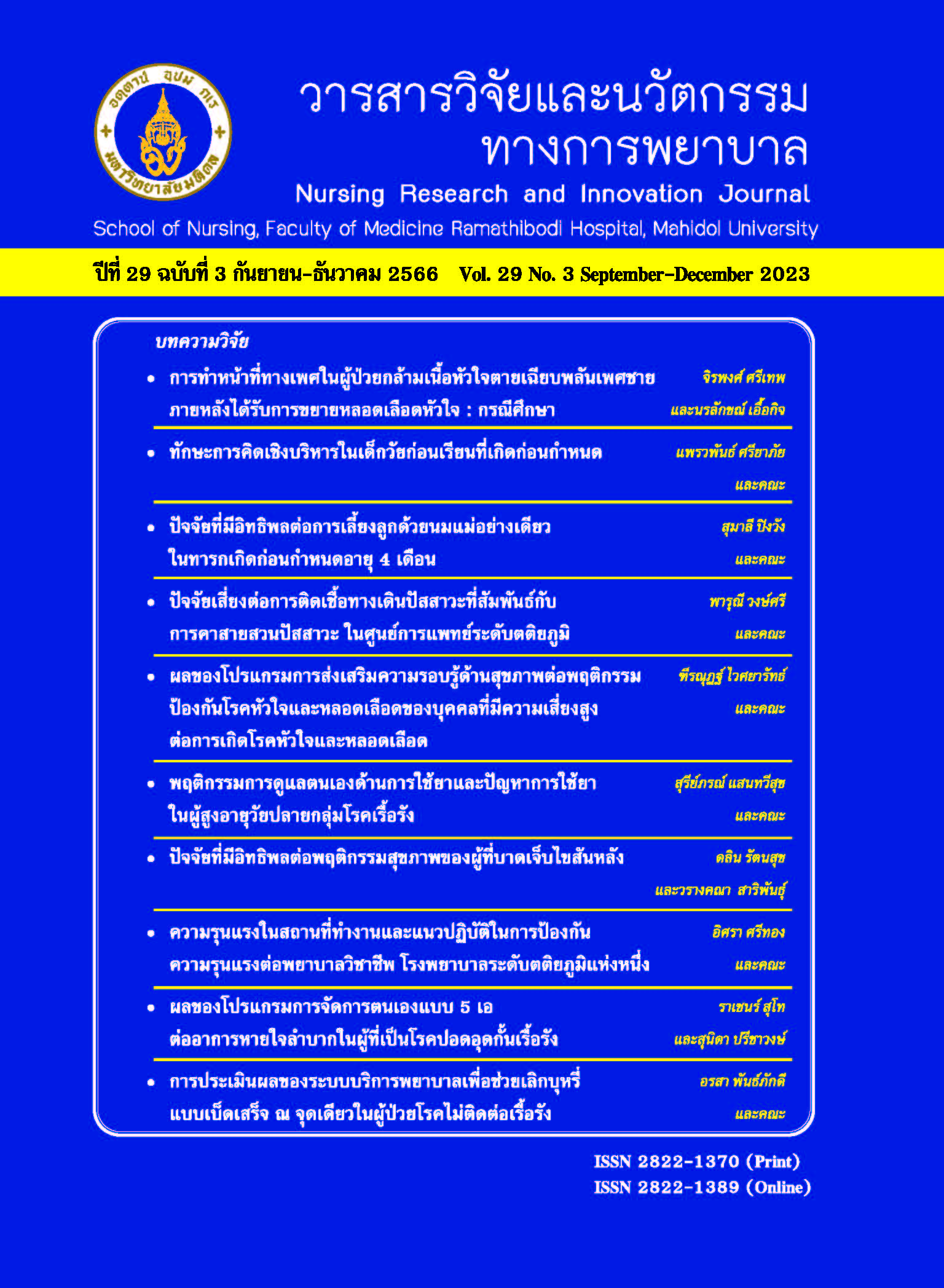An Evaluation of the One-Stop Nursing Service for Smoking Cessation in Persons with Non-Communicable Diseases
Main Article Content
Abstract
Smoking is an important risk factor for developing non-communicable diseases or chronic diseases.So, an easily accessible smoking cessation service system should be established, and health personnel should give advice and help smokers quit smoking as part of their regular work. This descriptive research aimed to evaluate a one-stop nursing service system to help quit smoking in persons with chronic diseases.The one-stop nursing service project evaluation used Stuffelbeam’s CIPP model to guide the study. The samples consisted of two groups: 30 nurses participating in the one-stop service and1,340 persons with chronic diseases and smoking.Data collection instruments consisted of a project evaluation form,a personal information record form,and a smoking record form. Data were analyzed using content analysis and descriptive statistics. The results revealed that the hospital and nursing administrators made efforts to put the smoking cessation policy into practice.Nurse administrators managed context and inputs and paid attention to the nursing practice process for smoking cessation.Brief intervention and motivational interviewing techniques were provided to enhance nurses’potential to assist with smoking cessation. During the nursing service process, nurses and nurse administrators met regularly,and the nurse administrator listened,helped solve problems,and encouraged them to work. This performance allowed the project to continue and follow up on persons who intend to quit smoking. The nursing service system that produced good results was that it had nurses specialized in smoking cessation working collaboratively with nurses in the clinics,all at one-stop service.It was found that persons with chronic diseases and smoking visited the outpatient clinics of seven hospitals.Almost all participants were male (94.70%),with an averageage of 58.29 years.Most nurses helped persons with chronic diseases quit smoking by using brief advice and
counseling combined with Thai herbs. The successful quitting rate was 35.88% within six months and 43.62% within one year, which is higher than the key performance indicatorof 20%. The study results showed that the nursing service system to help quit smoking is comprehensive as a one-stop nursing service at clinics. Adjustment of a one-stop nursing service system can increase assistance for persons with chronic diseases in quitting smoking. It isworth promoting hospitals to have a policy to help people access smoking cessation through a one-stop nursing service. Nurses should be encouraged to receive training to help quit smoking in persons with chronic diseases using services in hospitals. Expanding training on smoking cessation to other personnel in the hospital is essential.
Keywords: Brief advice and counseling,Motivational interviewing,Non-communicable diseases, One-stop nursing service system,Smoking cessation
Article Details

This work is licensed under a Creative Commons Attribution-NonCommercial-NoDerivatives 4.0 International License.
บทความ ข้อมูล เนื้อหา รูปภาพ ฯลฯ ที่ได้รับการตีพิมพ์ในรามาธิบดีพยาบาลสาร ถือเป็นลิขสิทธิ์ของวารสาร หากบุคคลหรือหน่วยงานใดต้องการนำทั้งหมดหรือส่วนหนึ่งส่วนใดไปเผยแพร่หรือเพื่อกระทำการใด ใด จะต้องได้รับอนุญาตเป็นลายลักษณ์อักษรจากรามาธิบดีพยาบาลสารก่อนเท่านั้น
References
Mwenifumbo JC, Tyndale RF. DSM-IV, ICD-10 and FTND:Discordant tobacco dependence diagnoses in adult smokers. J Addict Res Ther. 2011;2(1):105. Doi: 10.4172/2155-6105.1000105.
World Health Organization. Noncommunicable diseases and mental health: about 9 voluntary global targets [cited 2019 March28].Available from World Health Organization Web site: https://www.who.int/nmh/ncd-tools/definition-targets/en
Benjakul S, Kengganpanich M, Kengganpanich T, &Sujirarat D. Disease and health prediction report: trends in Thailand’s tobacco consumption. Nonthaburi: Nice Earth Design; 2015. (in Thai)
World Health Organization. Technical briefing tobacco interventions for the appendix 3 of global action plan for non-communicable disease [cited 2019 March 28].Available from World Health Organization Website:www.who/governance/tobacco_use
Sumalee H,Pitayarangsarit S,IamananP,Tangcharoensathien V. Assessment of smoking cessation services in Public Health Ministry-affiliated hospitals. JHSR. 2015;9(3):241-52. (in Thai)
Fiore MC, Jaen CR, Baker TB, Bailey WC, Benowit N,Curry SJ, et al. Treating tobacco use and dependence:2008 update clinical practice guideline.Rockville,MD:US Department of Health and Human Services; 2008.
Panpakdee O, Siripitayakunkit A, Likitluecha N, &Senadisai S. A survey of nursing practice on smoking cessation in Thailand. TJN. 2017;66(1):1-8.(in Thai)
Lapi-e A, Saksung A, Tumsuwan P, Sittichok T, Natee W, Tongrung S. Evaluation of the “3 Million people, 3 Years for Stop Smoking Therdthai King”project by using CIPP model a case study of Songkhla province and Sutun province. Parichart Journal. 2018;31(3):89-102.
(in Thai)
Sirimanssakul K,Jiwaramanonaikul T.Evaluation of report system of full range of smoking cessation support services
[cited 2023 October 28]. Available from Ministry of Public Health Web site: https://www.ddc.moph.go.th/ uploads/publish/1482620231009035758.pdf
Stufflebeam DL,Shinkfield AJ.Evaluation theory,models,and applications.San Francisco: Jossey-Bass; 2007.
Office of theTobacco Product Control Committee.Tobacco control action plan 2022-2027.Bangkok:Aksorngraphic and Design; 2022. (in Thai)
Iamsuwan A. Sirimanssakul K, Meesabpawang P,Kulsuwan P. Analysis of the implementation results of the National Tobacco control strategic plan,expanded version 2020-2021 at the reginal level [cited 2023 May 31].Available from Ministry of Public Health Web site:https://ddc.moph.go.th/otpc/journal_detail.php?publish=13791
National Statistical Office. The smoking and drinking behavior survey.Bangkok:Pimdeekarnpim;2018.(inThai)
Center for Disease Control. Smoking cessation-the role of healthcare professionals and health systems [cited 2022 July 28]. Available from Center for Disease Control Website: https://www.cdc.gov/tobacco/data_statistics/sgr/2020-smoking-cessation/fact-sheets/healthcare-professionals-health-systems/index.html
Winkelmann J,Scarpetti G,Williams GA,MaierCB.How can skill-mix innovations support the implementation of integrated care for people with chronic conditions and multimorbidity? [cited 2022 August 8]. Available from: https://apps.who.int/iris/handle/10665/358467


